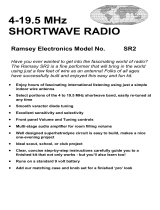Page is loading ...

Spring Reverb V2: Assembly Manual
PCB1: (The smaller one)
Solder the next resistors:
Amm. Value Code Name on PCB
2 2r2 OHM Red, red, blac, gold R8, R9
2 390 OHM Orange, White, Brown, gold R45, R49
4 470 OHM Yellow, Purple, Brown, Gold R25, R26, R35, R36
4 680 OHM Blue, Grey, Brown, Gold R22, R24, R28, R31
1 1k Brown, Black, Red, Gold1541F R18
2 1k5 1541F R37, R39
2 1k8 Brown, grey, Red, gold R46, R50
1 7k32 Purple, Orange, Red, Brown, Brown R33
13 10k Brown, Black, Black, Red, Brown R1, R3, R7, R10, R11, R12, R15, R16,
R17, R38, R42, R44, R48
2 15k Brown, Green, Orange, Gold R29, R30
1 27k Red, purple, Orange, gold R2, R13
2 36k Orange, blue, Orange, gold R4, R20,
2 47k Yellow, Purple, Black, Red, Brown R19, R23
1 62k Blue, red, Orange, gold R21
8 100k Brown,Black,Black,Orange,Brown R2,R14, R27, R32, R40, R41, R51, R52
1 200k Red, black, yellow, gold R47
2 820k Grey, red, black, gold R34, R43
Solder the diodes ( D1, D2 ) respecting polarity. Black line on the diode must be in the
same place as white line on the diode PCB silkscreen.
Solder the next capacitors:
Amm. Value Code Name on PCB
2 47p 47 C13, C17
5 100p 101 C2, C3, C10, C15, C18
1 1n 102 Poliester C9
1 15n 153 Poliester C8
12 100n 104 C1, C5, C6, C7, C11, C12, C14, C16,
C20, C21, C23, C24
2 10µF 10µF C19, C22
Solder the transistors 2n3906 (T1, T2,), BC516 (Q2) Y BC517 (Q1).Be sure they are on
proper position (same as the silkscreen on the PCB)
Solder the two ferrite beads (FERRITE+, FERRITE-)passing trough a recycled resistor leg.
Place the sockets (IC1, IC2, IC3, IC4, IC5) and solder them. Then place the ICs on them
taking care of polarity. To do that the mark on front must match the mark on the socket.
IC1=TL072, IC2=TL074, IC3=LM13700, IC4=LM13700, IC5=TL074.
Solder the power connector been sure the position is correct (as in the silkscreen)

Place and solder the RCA connectors (same as the silkscreen on the PCB).
Note:
RCA-OUT pcb –--> IN-Reverb.
RCA-IN pcb –--> OUT-Reverb.
Solder the male pin header (Circuit) by the short part and by the silkscreen side of the
PCB. Ensure they are at 90º from the PCB.
PCB2:
Solder the next resistors:
Amm. Value Code Name on PCB
1 1k Brown, Black, Red, Gold R100
1 1k8 Brown, grey, Red, gold R105
4 10k Brown, Black, Black, Red, Brown R106, R107, R108, R109
1 36k Orange, blue, Orange, gold R112
6 100k Brown,Black,Black,Orange,Brown R101, R102, R103, R104, R110, R111
Solder the diode ( D100 ) respecting polarity. Black line on the diode must be in the
same place as white line on the diode PCB silkscreen.
Solder the next capacitors:
Amm. Value Code Name on PCB
1 680n 684 C101
1 10µF 10µF C100
Place the sockets (IC100) and solder them. Then place the ICs on them taking care of
polarity. To do that the mark on front must match the mark on the socket. IC100=LM3914N.
Place and solder the Female Pin Header (Panel To) by the opposite side of the faders,
ensuring it is 90º from PCB.
Solder the potentiometer HPF Y MIX.
Place the faders, ensure they are at 90º from the PCB.and then solder them.
Put LEDs on place: (LED01 Rojo), (LED02, LED03 Amarillo), (LED04, LED05, LED06, LED07
Verde) especting the polarity but don't solder it until you screw the front panel. This
way is much more easy to solder it on the right position.
Solder the minijack or the Banana (CV1, CV2, IN1, IN2, MIX_CV, OUT_MIX, WET).
Put the spacer on the four holes by the male side and fix the with the four nuts.
Place the front panel, screw the minijacks or bananas and poceed to solder them.
Solder the LEDs on the right height.
Assembly the PCB 1 on the PCB2 and screw them with the four provided screws.

/












